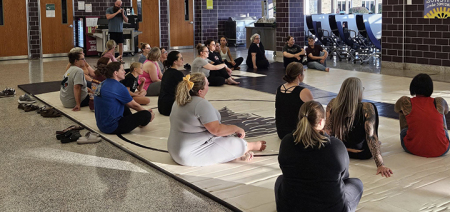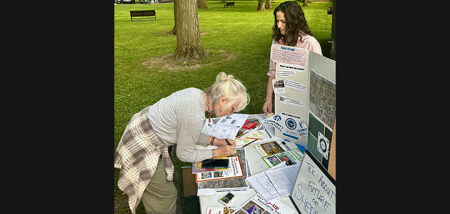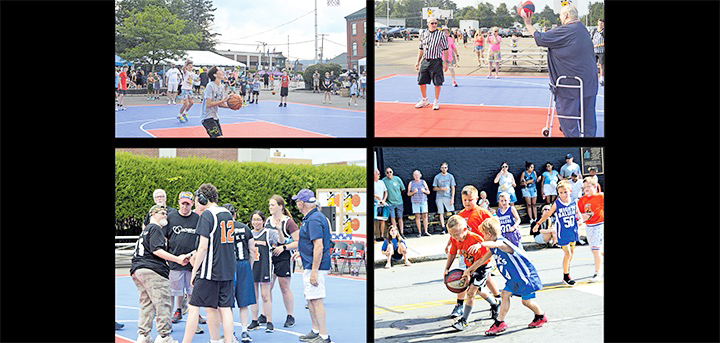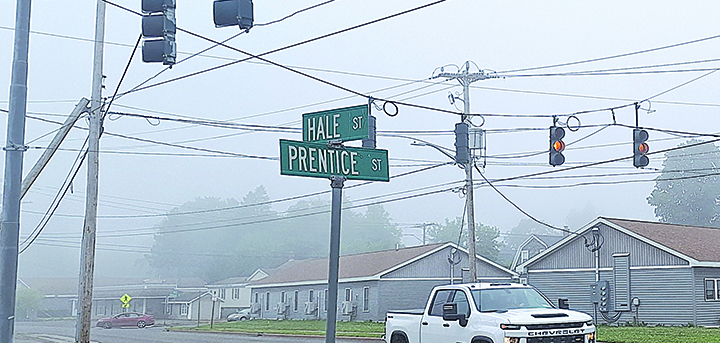Is My Dog Happy?
Published:
April 13th, 2023
By:
Sarah Genter
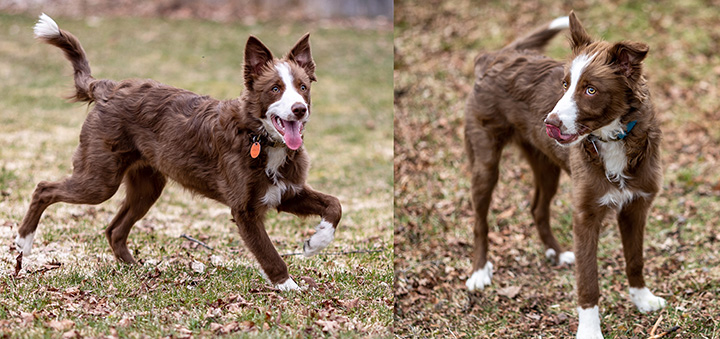 (Left) What can you tell from Ripley's body language? Her perked ears, soft eyelids, open mouth, and lolling tongue all indicate that she's happy and having a good time! (Right) Based on her communication signals, what do you think Ripley is trying to say in this photo? She's breaking eye contact by turning her head away and glancing back at the camera in a display of "whale eye," and she's licking her nose and lips. This is her way of saying she's feeling a little uncomfortable – maybe she's a bit camera shy! (Photos by Dustin Genter of 5th Dimension Photography)
(Left) What can you tell from Ripley's body language? Her perked ears, soft eyelids, open mouth, and lolling tongue all indicate that she's happy and having a good time! (Right) Based on her communication signals, what do you think Ripley is trying to say in this photo? She's breaking eye contact by turning her head away and glancing back at the camera in a display of "whale eye," and she's licking her nose and lips. This is her way of saying she's feeling a little uncomfortable – maybe she's a bit camera shy! (Photos by Dustin Genter of 5th Dimension Photography)
I’m sure as dog owners we’ve found ourselves at one time or another wondering if our dogs are happy. I’m only a little embarrassed to admit that a few weeks after I brought home my dog Penny, I started Googling things like, “Is my dog happy?” and “Does my dog like me?”
When I enrolled in a course to become a certified dog trainer, one of the things I was most excited to learn about was dog communication and behavior. Not only is it a fascinating subject, but I would learn how to tell what my dog was feeling, so I would always know if she was in good spirits.
Is my dog happy?
One of the simplest signals of a happy and content dog is a relaxed body and relaxed features. A happy and comfortable dog will have a relaxed posture and a neutral tail position. Ears that are in a neutral position or shifted slightly backward can also indicate that your dog is perfectly at ease!
Gauging the position of your dog’s ears can be a little tricky. Some dogs have flopped over ears, while others have pointed ears, and dogs like basset hounds will have long, drooping ears. Or, in my case, your dog might have one floppy ear and one pointy ear – I’m still trying to figure out how to read that!
An easy(-ish) way to tell if your dog’s ears are relaxed is by looking at the base of the ear, where they connect to his head. You can try to see if the base, or root, of the ear is pushing slightly backward or perked forward.
Relaxed eyelids, or “soft” eyes, are another signal that your dog is happy. You can also take a look at your dog’s mouth: relaxed lips, slightly upturned corners, or an open mouth or lolling tongue are all signs of contentment.
Of course, we all know the telltale sign of a happy dog: a wagging tail! But, the way your dog’s tail is wagging can give further insight into what exactly they’re feeling. Essentially, tail wagging indicates some type of emotional arousal, whether it be excitement or frustration.
Loose, wide, back and forth sweeps of the tail points to a comfortable and relaxed dog. You may notice this type of wag when your dog greets a person or another dog, and it’s a sign they’re happy to see them.
If your dog’s tail is sticking up and wagging rapidly in a circular motion, they’re displaying what’s known as a “helicopter tail.” This indicates excitement, and the faster the wag, the more emotionally aroused your dog is. You may find your dog’s helicopter tail comes out when you go for a walk or to the dog park, or when they get to see a favorite animal or human friend.
Signs of stress
We all want our dogs to be happy and comfortable all the time, but sometimes your dog may end up in unfamiliar or uncomfortable situations. Fortunately, there are signals you can watch for so you’ll notice if your dog is getting stressed.
Many of these behaviors are known as calming signals, in which a dog is trying to communicate to others that they are overwhelmed, stressed, or afraid. You may notice these behaviors when your dog is in unfamiliar settings or situations, when doing things they associate with unpleasantness, such as visiting the vet, or even when they meet new people or dogs.
While relaxed eyes are a sign that your dog is happy, your dog may relax his eyes to the point it looks like he’s squinting. This behavior is recognized by other dogs as a request to calm down. An excited, overzealous dog may be too much for another dog to handle, so they may squint to show they want the situation to relax.
There is also eye contact to consider. Dogs generally won’t use more than brief moments of eye contact with each other, and so they may try to break eye contact to de-escalate a situation they find stressful.
Some ways they do this are by turning their head away repeatedly, sniffing the ground, or itching their neck with a hind leg – a behavior that’s comparable to a nervous human picking at their nails or biting their lips.
To de-escalate what they perceive as threatening, dogs may turn their head away while glancing back at you, displaying what’s known as “whale eye.”
When dogs display whale eye, you’ll be able to see the whites of their eyes in a thin crescent moon shape. Many people perceive this as a guilty look, but dogs don’t really feel guilt in the way we do. It’s more likely they’re actually responding to an owner’s scolding or harsh tone after getting into mischief!
You’ve probably seen your dog lick his lips before, usually around the smell of cooking food or when they’re anticipating their nightly bowl of kibble. But when your dog is feeling unsure about something, such as meeting a new person or dog, he might signal his discomfort by licking his nose and lips. This signals to the other dog that he’s nervous, and ideally, the other dog will respond with non-threatening or calming body language.
One of the behaviors I found most interesting is that of a dog “shaking off.” You might picture a dog shaking water off their fur after a bath, which is a normal behavior. But dogs who shake in the same manner when they’re dry are doing so to release stress.
We humans might let out a big sigh as a way to calm our nerves after emotionally-charged experiences, such as after an argument, before going in for a job interview, or after watching an intense movie. Dogs use shaking off in the same way – they’re trying to calm down after a tense or exciting experience.
Keep in mind that this is in no way an exhaustive list of behaviors – there are many other signals your dog may use to indicate discomfort. Try to take note of both the obvious and subtle body language your dog displays, and Google anything you don’t recognize to get better insight into what your dog is feeling.
Of course, any time you notice a sudden or drastic change in your dog’s behavior, it’s always a good idea to check in with your vet to rule out any underlying medical or behavioral issues.
Use body language to talk to your dog
My favorite thing about learning canine communication is that I now know how to communicate with my dog in a way that she understands. It can be really cool to display a canine communication signal and see your dog understand and react to it. Plus, I now know how to tell when she's getting stressed, and can try to make the situation better for her.
Just the other day I was trying to teach Penny the “touch” cue, and she was having a tough time figuring it out. After a few minutes she began to repeatedly turn her head away from me. When I didn’t pick up on her signal, she started to itch at her neck as well. That finally clued me in that she was getting too stressed by the training, and we took a break to play.
Knowing what signals to watch for will let you know when your dog has had enough training for the time being, is overwhelmed by people or other animals, or is otherwise uncomfortable. Then you can take steps to ease their stress.
It can take some practice to recognize what is an intentional behavior and what is simply a dog naturally responding to their environment. For example, a dog may be turning away from you repeatedly because they are trying to break eye contact, or because they are just distracted by something else in the room. Make sure to look at the context surrounding the behavior to figure out if your dog is showing a calming signal or not.
If your dog gets nervous, or you’re around anxious or stressed dogs, there are ways you can communicate to them that you’re not a threat. Dogs will often sit down to show they want the other dogs around them to calm down, and even around people if they can tell they’re getting agitated. To soothe a nervous dog, try sitting on the ground with them! It’s a way of communicating that they understand, and it should help calm their nerves.
If your dog is being too rambunctious or is getting too excited at an inopportune time, try looking at them with a soft gaze, and gently squint your eyes to tell them it's time to settle down. You might find that they begin to squint in return, and they may begin to settle down in response to your signal.
If you notice your pup gazing at you with soft eyes, it may also be their way of showing you affection – how cute is that! Along those same lines is prolonged, soft eye contact. Prolonged eye contact with a familiar human can actually release oxytocin in both dog and human brains, and strengthen the bond or connection between the two.
I encourage you to try reading your dog’s body language to read what they’re communicating to you! It can be really fun, and I feel much more connected to my dog now that I speak her language a bit more.
It might be overwhelming to try to take in all the different signals at once, so try reading a single body part at a time, such as the eyes or tail. As you get more comfortable, it’ll become easier to notice and understand several facets of your dog’s body language at once.
I like to make a game out of it – if I'm out on a walk or running errands and see a dog, I like to do a quick scan of their body language to see what information I can gather. It's fun, and a great way to get better at reading canine communication signals!
Do you have any questions about dog communication, or a question about dog training? Send me an email at sgenter@evesun.com to have your questions answered in a future column. As I’m still earning my certification to become a dog trainer, I may wait to answer some questions until I feel I have the necessary knowledge and training to provide thorough and accurate responses.
Author: Sarah Genter - More From This Author
Comments

